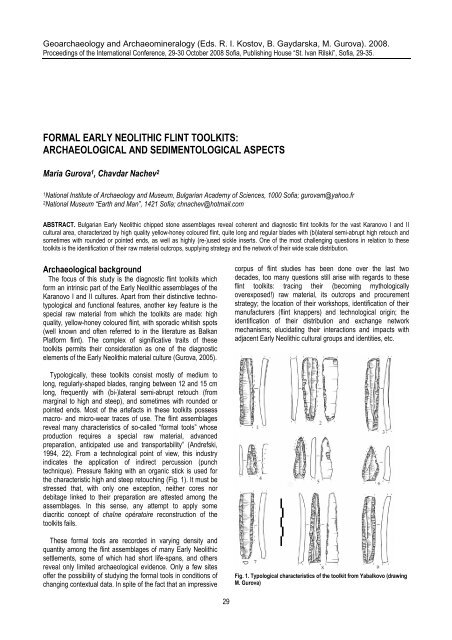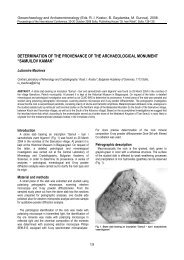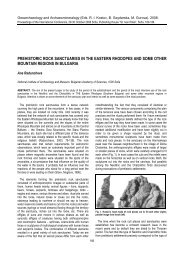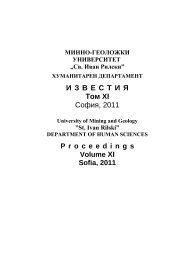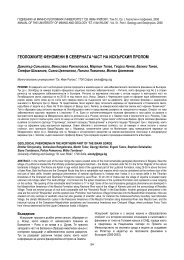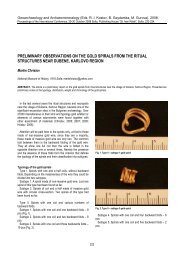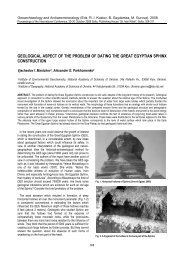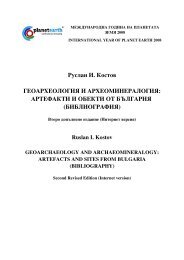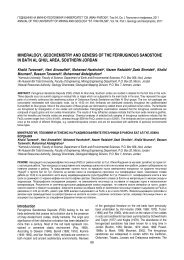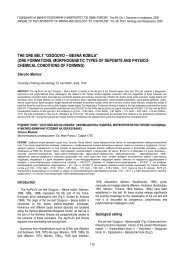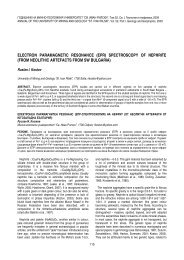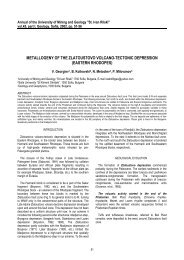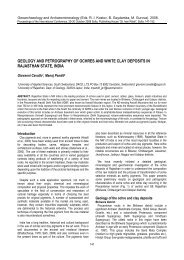FORMAL EARLY NEOLITHIC FLINT TOOLKITS ...
FORMAL EARLY NEOLITHIC FLINT TOOLKITS ...
FORMAL EARLY NEOLITHIC FLINT TOOLKITS ...
Create successful ePaper yourself
Turn your PDF publications into a flip-book with our unique Google optimized e-Paper software.
Geoarchaeology and Archaeomineralogy (Eds. R. I. Kostov, B. Gaydarska, M. Gurova). 2008.<br />
Proceedings of the International Conference, 29-30 October 2008 Sofia, Publishing House “St. Ivan Rilski”, Sofia, 29-35.<br />
<strong>FORMAL</strong> <strong>EARLY</strong> <strong>NEOLITHIC</strong> <strong>FLINT</strong> <strong>TOOLKITS</strong>:<br />
ARCHAEOLOGICAL AND SEDIMENTOLOGICAL ASPECTS<br />
Maria Gurova 1, Chavdar Nachev 2<br />
1 National Institute of Archaeology and Museum, Bulgarian Academy of Sciences, 1000 Sofia; gurovam@yahoo.fr<br />
2 National Museum “Earth and Man”, 1421 Sofia; chnachev@hotmail.com<br />
ABSTRACT. Bulgarian Early Neolithic chipped stone assemblages reveal coherent and diagnostic flint toolkits for the vast Karanovo I and II<br />
cultural area, characterized by high quality yellow-honey coloured flint, quite long and regular blades with (bi)lateral semi-abrupt high retouch and<br />
sometimes with rounded or pointed ends, as well as highly (re-)used sickle inserts. One of the most challenging questions in relation to these<br />
toolkits is the identification of their raw material outcrops, supplying strategy and the network of their wide scale distribution.<br />
Archaeological background<br />
The focus of this study is the diagnostic flint toolkits which<br />
form an intrinsic part of the Early Neolithic assemblages of the<br />
Karanovo I and II cultures. Apart from their distinctive technotypological<br />
and functional features, another key feature is the<br />
special raw material from which the toolkits are made: high<br />
quality, yellow-honey coloured flint, with sporadic whitish spots<br />
(well known and often referred to in the literature as Balkan<br />
Platform flint). The complex of significative traits of these<br />
toolkits permits their consideration as one of the diagnostic<br />
elements of the Early Neolithic material culture (Gurova, 2005).<br />
Typologically, these toolkits consist mostly of medium to<br />
long, regularly-shaped blades, ranging between 12 and 15 cm<br />
long, frequently with (bi-)lateral semi-abrupt retouch (from<br />
marginal to high and steep), and sometimes with rounded or<br />
pointed ends. Most of the artefacts in these toolkits possess<br />
macro- and micro-wear traces of use. The flint assemblages<br />
reveal many characteristics of so-called “formal tools” whose<br />
production requires a special raw material, advanced<br />
preparation, anticipated use and transportability” (Andrefski,<br />
1994, 22). From a technological point of view, this industry<br />
indicates the application of indirect percussion (punch<br />
technique). Pressure flaking with an organic stick is used for<br />
the characteristic high and steep retouching (Fig. 1). It must be<br />
stressed that, with only one exception, neither cores nor<br />
debitage linked to their preparation are attested among the<br />
assemblages. In this sense, any attempt to apply some<br />
diacritic concept of chaîne opératoire reconstruction of the<br />
toolkits fails.<br />
These formal tools are recorded in varying density and<br />
quantity among the flint assemblages of many Early Neolithic<br />
settlements, some of which had short life-spans, and others<br />
reveal only limited archaeological evidence. Only a few sites<br />
offer the possibility of studying the formal tools in conditions of<br />
changing contextual data. In spite of the fact that an impressive<br />
29<br />
corpus of flint studies has been done over the last two<br />
decades, too many questions still arise with regards to these<br />
flint toolkits: tracing their (becoming mythologically<br />
overexposed!) raw material, its outcrops and procurement<br />
strategy; the location of their workshops, identification of their<br />
manufacturers (flint knappers) and technological origin; the<br />
identification of their distribution and exchange network<br />
mechanisms; elucidating their interactions and impacts with<br />
adjacent Early Neolithic cultural groups and identities, etc.<br />
Fig. 1. Typological characteristics of the toolkit from Yabalkovo (drawing<br />
M. Gurova)
Chronological and spatial features of the formal<br />
toolkits<br />
In order to put the discussed problem in adequate<br />
chronological framework, we present the division of the Early<br />
Neolithic in Bulgaria, according to the recent study on absolute<br />
dates (Boyadziev, 1995, 179): Early pottery (‘monochrome”<br />
phase) 6300/6200 – 6000/5900 cal BC; Early (‘classical”<br />
phase) 6000/5900 – 5500/5450 cal BC. Regarding the time<br />
span of the toolkits under discussion and their function, it is<br />
useful to point out that they are abundant during the whole<br />
“classical” Early Neolithic Karanovo I and II periods of the Tell<br />
Karanovo sequence, or until ca 5500 cal BC. On the other<br />
hand, in terms of their lasting ‘retardation’ in the same<br />
sequence, the end of the Karanovo III period at Tell Karanovo:<br />
5500-5280 cal BC (Görsdorf, 1997, 379) can be regarded as a<br />
terminus ante quem for the presence of formal toolkits.<br />
Spatial distribution of the formal toolkits<br />
Local distribution<br />
The formal toolkits are commonly found in the vast area of<br />
the Karanovo I and II cultures and their constituent regions in<br />
Southern Bulgaria: Thrace – the Tells Azmak, Karanovo and<br />
Kapitan Dimitrievo, and the Yabalkovo site; the Northern<br />
foothills of the Rhodope Mountains – the Rakitovo site, the<br />
Sofia Plain – Slatina; and the valley of Struma – Kovačevo<br />
(Fig. 2). The map shows sites in Western Bulgaria, which have<br />
been published (Gatsov, 1993). Other research has been<br />
undertaken by the author, and some of this work is still in<br />
progress (Gurova, 1997, 2001, 2001, 2004, 2005, in press). In<br />
North Bulgaria the flint industry exhibits a very different pattern<br />
30<br />
(exclusively expedient in character and an absence of the<br />
formal tools under discussion here), despite the fact that a<br />
proportion of the artefacts were made of the same raw material<br />
as used for the manufacturing of the discussed formal tools.<br />
Two sites belonging to the “monochrome” phase of the Early<br />
Neolithic sequence are marked in blue in recognition of their<br />
important position in the context of the Neolithisation debate.<br />
Supra-regional distribution<br />
Formal toolkits as a distinguishable category of the Early<br />
Neolithic flint repertoire have never before been discussed in<br />
the literature on the complex technological and social<br />
dimensions. Nevertheless some aspects of their stylistic<br />
‘coherence’ have often been observed in the course of work on<br />
different assemblages from adjacent major cultural areas –<br />
Proto-Sesklo, Starčevo and Körös-Criş. The most common<br />
feature mentioned in these studies is the presence of raw<br />
material from the Pre-Balkan platform among the Early<br />
Neolithic assemblages from the Balkans.<br />
According to C. Perlès a characteristic feature of the<br />
chipped-stone assemblages of Neolithic Greece is the<br />
“predominant use of non-local raw materials often obtained<br />
from considerable distances” (Perlès, 2001, 201). Recently,<br />
interesting and promising research has been done by G.<br />
Filippakis on the north Greek Neolithic assemblages, coming<br />
from outside the obsidian area. I hope our further study and<br />
collaboration will lead to positive issues of reliable comparison<br />
of the assemblages from both regions – Bulgarian Thrace and<br />
Greek Macedonia.<br />
Fig. 2. Map with Early Neolithic sites: triangles without numbers – western group studied by Gatsov; grey triangles – study and direct observation of the<br />
author; numbers 9 &10 – ‘monochrome pottery’ sites. The three main flint outcrops are indicated by white signs in relation to modern cities. Arrows<br />
indicate presumed directions of: spread of Neolithisation – black; distribution of Dobrudzha flint – white. Numbered sites: 1 – Kovačevo; 2 – Slatina; 3 –<br />
Rakitovo; 4 – Kapitan Dimitrievo; 5 – Yabalkovo; 6 – Azmak; 7 – Karanovo; 8 – Dzhuljunitsa; 9 – Koprivets; 10 – Ohoden
From the Ovče Pole region the crucial culture group of<br />
Anzabegovo is very promising, but still enigmatic from a lithic<br />
point of view. However the researcher, Elster mentioned that<br />
among the implements there was “honey-brown flint appearing<br />
to be similar to well known eastern European flint with no<br />
known local source” (Elster, 1977, 161).<br />
The Iron Gates region will be also mentioned on the basis of<br />
Borić’s assessment on the lithic industries underlying “…a<br />
general trend toward the laminarization of blades and the use<br />
of steep retouch, as well as a tendency to use good quality raw<br />
material of attractive appearance, such as yellow-spotted flint<br />
from pre-Balkan platform that most likely originated in the<br />
region of Shumen in North-East Bulgaria” (Borić, 2005, 19).<br />
According to Kozłowski, the tardif phase of Golocut<br />
(Voyvodina) offers some dozen implements of yellow flint from<br />
the Pre-Balkan platform; the drawings of some implements<br />
from the site confirm the typological similarity with the formal<br />
tools discussed in this paper (Kozłowski, 1982, 150, Figs. 11-<br />
12). The same author concludes that in the area of the Körös-<br />
Criş culture there are retouched blades and unretouched sickle<br />
segments made of yellow imported flint – as a result of direct<br />
diffusion from the Balkans (Kozłowski, 1982, 154). In the<br />
Southeast there is undeniable evidence of penetration of<br />
formal tools of Karanovo I aspect in Hoca Çeşme phase II<br />
(Gatsov, 2000; 2005).<br />
Comparative evidence from the Romanian Early Neolithic<br />
flint assemblages is very limited and the distribution of “yellowspotted”<br />
raw material and items in this direction is still to be<br />
adequately documented, although Bonsall has reported the<br />
presence of Balkan flint artefacts in Criş culture contexts at<br />
Schela Cladovei on the left bank of the Danube, a few km<br />
downstream from the Iron Gates gorge (Bonsall, 2003; 2008).<br />
As a concluding remark it should be stressed that no special<br />
study elucidating the scale and intensity of the circulation and<br />
spread of yellow-spotted flint artefacts has been undertaken.<br />
The reasons are many, the most important being the scarcity<br />
of publications with relevant and detailed information about<br />
Early Neolithic flint assemblages among which these formal<br />
toolkits are detectable. This applies particularly to some<br />
emblematic sites adjacent to Bulgarian lands and cultural<br />
areas.<br />
Raw material for the toolkits: where from?<br />
How should we summarize our knowledge of the raw<br />
material parameters of Early Neolithic assemblages and, in<br />
particular, their formal toolkits? It has already been mentioned<br />
that foreign specialists have drawn attention to the high quality<br />
and yellow-honey-waxy colour of a particular raw material,<br />
originating from North-Еast Bulgaria (Pre-Balkan platform) and<br />
its spread across the region. One study fixed the provenance<br />
in the vicinity of Shumen (Voytek, 1987).<br />
At local scale the research has gone more slowly. There<br />
have been some sporadic studies of cryptocrystalline siliceous<br />
rocks ‘flint” over the past three decades. The first archaeologist<br />
to show the abundance and variety of the flint sources from<br />
North-Еast Bulgaria, who also tried to establish a database and<br />
a link of the identified flint outcrops to prehistoric artefacts and<br />
their circulation, was Kanchev (1978; Kanchev et al., 1981).<br />
31<br />
In his publication Gatsov (1993) presumed North-west<br />
Bulgaria to be the region of provenance of the raw material<br />
used for Early Neolithic assemblages from Western Bulgaria<br />
(vide supra). At the same time, Skakun noticed that “certain<br />
specimens are probably made of Dobrudzha flint”. On the<br />
basis of her deep knowledge of North-East Bulgarian flint<br />
assemblages both from the Neolithic and Chalcolithic, she<br />
conceived this fact rather as accidental emphasizing that the<br />
exploitation of Dobrudzha flint started no earlier than the<br />
Chalcolithic (Skakun, 1993, 54). She had already reached the<br />
same conclusion about a dozen implements from the ‘big<br />
house’ of Slatina (Skakun, 1992, 102).<br />
There are two general types of flint recognised among the<br />
assemblages from the Tells Karanovo and Azmak. The<br />
investigation was done by V. Kurčatov who suggested that the<br />
abundance of artefacts was due to the proximity of local<br />
outcrops and identified them (more theoretically than actually)<br />
in the region of the Sveti Ilia Hills in Eastern Thrace, not very<br />
far from the tells (Gatsov, Kurčatov, 1997, 215). This<br />
assumption has been quoted repeatedly, but never<br />
substantiated by further serious research. In fact, it could be<br />
considered as disproved.<br />
Preliminary research on a series from Yabalkovo has led<br />
Zlateva-Usunova to reveal that “…the predominant raw<br />
material with identified origin comes from deposits in the Upper<br />
Thrace, the Sredna Gora, North (understand Western) Bulgaria<br />
and the Eastern Rhodopes” (Leshtakov et al., 2007, 201). In<br />
fact, the first to presume, somewhat theoretically, a northeastern<br />
provenance for the raw material used for the Neolithic<br />
big blades was Tsonev. He did this in the context of his theory<br />
about the role of long blades in “communal perception of long<br />
distance exchange through common metaphors” (Tsonev,<br />
2004, 262).<br />
The research initiated by the present author (M. Gurova), in<br />
collaboration with the mineralogist Ch. Nachev, comprises<br />
analysis of archaeological artefacts from the sites of Karanovo,<br />
Kovačevo, Rakitovo, Yabalkovo and Dzhuljunitsa and different<br />
flint outcrops from the country in order to identify the<br />
provenance of the formal Early Neolithic toolkits raw material.<br />
Microscopic and comparative analyses of thin sections from<br />
the mentioned materials are in progress (Figs. 3, 4).<br />
Fig. 3. Cryptocrystalline chalcedony and micro fauna filled with microcrystalline<br />
chalcedony – blade fragment, archaeological site Rakitovo,<br />
sample N582; possible source – Upper Cretaceous (Moesian flint);<br />
transmitted light, crossed polars
Fig. 4. Cryptocrystalline chalcedony, microfauna filled with microcrystalline<br />
chalcedony and clastic particles – blade fragment, Neolithic<br />
archaeological site Yabalkovo, sample N18; possible source – Upper<br />
Cretaceous (Moesian flint); transmitted light, crossed polars<br />
Further thin section analyses should reduce the potential<br />
candidates for original outcrops of the toolkits under<br />
discussion. Although archaeological evidence for Neolithic<br />
workshops in the region of North-East Bulgaria is absent, we<br />
have to presume that they existed in the Early Neolithic for<br />
ensuring suitable nodules, cores (about 18-20 cm long) and<br />
debitage (blades): all these products were predestined for long<br />
distance exchange of good and perhaps embodied know-how.<br />
Sedimentological aspects of prehistoric flints<br />
The siliceous concretions (flint) are relatively well studied in<br />
Bulgaria. The published sedimentological works are about<br />
Upper Jurassic siliceous concretions in West Bulgaria<br />
(Atanasov, 1954; Nachev, 2005), Low Cretaceous flint in<br />
Northeast Bulgaria (Goranov, 1965; Nachev, Kanchev, 1984;<br />
Nachev, 2008, in press) and Upper Cretaceous siliceous<br />
concretions (Soultanov, 1982; Nachev, 2008 in press).<br />
32<br />
Part of the present work is based on sedimentological<br />
examinations of flint and flint-like materials from the territory of<br />
Bulgaria. They include terrain observation (more than 100<br />
localities), macroscopic observations (descriptions of<br />
specimens – 480 numbers) and microscopic descriptions (700<br />
thin-sections from 65 outcrops). The microscopic observations<br />
of artefacts with Neolithic and Chalcolithic age have<br />
preliminary character and are based on macro-and<br />
microscopic observations of 180 thin sections from 16<br />
archeological sites. According to some authors, the siliceous<br />
concretions (flint) consist from autogenic minerals of SiO2<br />
(silica). They have concretion structure and are hosted<br />
predominantly in limestones or chalk. The natural flint outcrops<br />
are widely spread in Bulgaria. The siliceous concretions are<br />
represented in almost geographic and morphotectonic zones.<br />
Significant accumulations are located in the Moesian<br />
Platform and adjustment parts of the Balkan Alpine Orogen<br />
(Fig. 5) (Nachev, Nachev, 1986). In the Phanerozoic rocks in<br />
Bulgaria the siliceous concretions are found in 16 stratigraphic<br />
levels and different paleogeodynamic environments are<br />
recognized (Nachev, Nachev, 1989). The main stratigraphic<br />
levels, which are of theoretical and practical interest for<br />
archeology, are the Upper Jurassic (Oxfordian), the Low<br />
Cretaceous (Aptian) and the Upper Cretaceous (Coniacian,<br />
Campanian and Maastrichtian).Some meaning in archaeology<br />
may have the hydrothermal chalcedony veins in the Upper<br />
Cretaceous Sredna Gora zone (Sredna Gora atypical flint) and<br />
in the Oligocene Rhodopes volcanic zone (Rhodopes atypical<br />
flint). The term “Pre-Balkan Platform” is not a correct term for<br />
Moesian Platform. The “Balkan flint” probably means every flint<br />
in the Moesian Platform and adjustment parts of the Balkan<br />
Alpine Orogen including both Low Cretaceous (Aptian) flint and<br />
Upper Cretaceous (Campanian and Maastrichtian) flint. The<br />
geographic and stratigraphic distribution of the main levels of<br />
siliceous concretions (flint) with archaelogocal significance in<br />
Bulgaria is shown on Fig. 5.<br />
Fig. 5. Geological map of the main types of flint-born rocks in Bulgaria: 1 – Upper Jurassic limestones (Oxfordian age) with siliceous concretions (J3 ox ) -<br />
Hemus flint; 2 – Low Cretaceous (Aptian age) limestones with siliceous concretions (К1 a ) – Luda Gora flint (Dobrudzha flint); 3 – Upper Cretaceous chalk<br />
and chalk-like limestones (Campanian and Maastrictian ages) with siliceous concretions (К2 cp-m ) – Moesia flint; 4 – Upper Cretaceous volcanogenous<br />
rocks (Coniacian, Santonian and Campanian ages) in Sredna Gora Zone (K2 Cn-Cp ) – Sredna Gora atypical flint; 5 – Chalcedony veins in Oligocene<br />
volcanogenous rocks in Rhodope Zone (Pg3) – Rhodope atypical flint ; 6 – boundary between tectonic zones
Hemus flint (J3 ox ). The silica concretions are hosted in grey<br />
micrite limestones (Nachev, 2005). The flint-rich level in<br />
limestones belongs to the Oxfordian age. The shape of the<br />
concretions is approximately ellipsoidal, with pale grey colour.<br />
The size of the concretions varies from 1 to 15 cm, mainly 8-10<br />
cm. A few low meters of the flint bearing section are of a<br />
brown-reddish color. The structure is massive, practically<br />
without inclusions. The crust is pale yellowish, from 0.2 to 1 cm<br />
in thickness. The grey flint formed characteristic yellow patina<br />
in water (alluvial and karst) conditions. The fracture is smooth<br />
(in grey varieties) – conchoidal in separate parts of the<br />
specimens. The brown-reddish varieties show rough fracture.<br />
This flint has many tectonic cracks in three directions like. The<br />
cracks are with calcite filling. Part of the specimens is strongly<br />
weathered. Very rarely are visible relics from limestones. The<br />
mineral composition is chalcedony, quartzine, quartz, and<br />
calcite. Biodetritus is from Foraminifera and Spongia (Porifera).<br />
All the biocomponents are silicified. The Upper Jurassic<br />
limestones are widespread and characteristic topography<br />
element in the district – there is abundance of small flint<br />
deposits in the region. Clearly observed are the following types<br />
of flint deposits: 1 – primary; 2 – secondary (placer). The<br />
secondary deposits are divided to the following genetic types:<br />
eluvial deposits; colluvial (slope embankments) deposits;<br />
proluvial deposits; alluvial (river) deposits; karsts deposits. The<br />
Upper Jurassic flint-rich limestones formed two stripes of<br />
outcrops in North-West Bulgaria. The first stripe is connected<br />
to the north branch of the Belogradchik anticline near<br />
Granitovo, Oreshets and Yanovets. The second stripe is<br />
related to the South branch of the Belogradchik anticline near<br />
Salash, Varbovo, Targoviste, Prevala and Dolni Lom. The<br />
Oxfordian flint is used as a local source of flint during the Early<br />
Paleolithic (1.3 Ma).<br />
Ludogorie or Luda Gora (Dobrogea) flint (К1 a ). The silica<br />
concretions are hosted in Low Cretaceous (Aptian) micrite<br />
limestones with pale grey colour. The colour of the concretions<br />
is predominantly pale brown or beige, very rarely grey. Very<br />
often it shows concentric-zonal structure (pale brown, reddish<br />
and grey stripes). The size varies from 1 to 50 cm, mainly 5-15<br />
cm, very rarely (30-50 cm). The shape is regular –<br />
approximately ellipsoidal, rarely may be rod-like. Distinctive<br />
feature is the white silica-carbonate crust, 6-12 mm thick, in<br />
separate specimens with onion weathering. The intercalations<br />
are very rare, small (1-5 mm), round, with a pale cream colour.<br />
The fracture is smooth (in brown and beige varieties),<br />
conchoidal or cone in separate part of the specimens.<br />
The grey varieties show a rough fracture. The mineral<br />
composition is micro- and cryptograin chalcedony, moganite<br />
and quartz. Biocomponents are only sponge spiculae which<br />
are fully silicified. The Aptian flint-rich limestones give material<br />
for different types of flint secondary (placer) deposits. The main<br />
of them are eluvium-proluvium deposits, where angular pieces<br />
of flint are hosted in soft sandy-carbonated masses. Such<br />
examples are Kriva Reka, Tetovo, Kamenovo, Ravno, Chukata<br />
(near Razgrad) etc. Another placer deposits in this region are<br />
from paleoalluvial type like Drianovets locality etc. The Aptian<br />
flint has a large geographic distribution in North East Bulgaria,<br />
to the North of Novi Pazar and between meridians of Rouse<br />
and Dobrich. The main outcrops are near Vetovo, Koubrat,<br />
Razgrad, Isperih and Novi Pazar. Clearly are distinguished two<br />
microscopic types of Ludogorie flint: the first one with micro- to<br />
33<br />
cryptoground mass and single sponge spiculae and the second<br />
– microcrystalline aggregates with recrystallization of<br />
chalcedony.<br />
The first one, named Ludogorie flint – Type Ravno (Figs. 6,<br />
7) is observed in the Northeast part of area – along the Topchii<br />
River near Topchii, Kamenovo, Ravno, Koubrat, Belovets,<br />
Tetovo, and Chereshovo. The second, named Ludogorie flint –<br />
Type Kriva Reka (Figs. 8, 9) is observed in the Southwest part<br />
Fig. 6. Cryptocrystalline chalcedony and sponge spiculae filled with<br />
microcrystalline chalcedony – siliceous concretion; deposit Ravno (near<br />
Kamenovo), sample N431, Low Cretaceous (Ludogorie flint – type<br />
Ravno); transmitted light, crossed polars<br />
Fig. 7. Cryptocrystalline chalcedony and sponge spiculae filled with<br />
microcrystalline chalcedony – nucleus from siliceous concretion;<br />
archaeological site Kamenovo, sample N5K1, Low Cretaceous<br />
(Ludogorie flint – type Ravno); transmitted light, crossed polars<br />
Fig. 8. Cryptocrystalline chalcedony and microcrystalline chalcedony –<br />
siliceous concretion; deposit Kriva Reka, sample N8-2, Low Cretaceous<br />
(Ludogorie flint – type Kriva Reka); transmitted light, crossed polars
Fig. 9. Cryptocrystalline chalcedony and microcrystalline chalcedony –<br />
siliceous concretion; deposit Goliam Porovets – Chakmaka (near<br />
Isperih), sample N4, Low Cretaceous (Ludogorie flint – type Kriva Reka);<br />
transmitted light, crossed polars<br />
of the area – between the villages of Goliam Porovets,<br />
Drianovets, Krivnia, Chukata (Razgrad), Lisi Vrah, Kriva Reka<br />
and Rouzhitsa. The Ludogorie flint – Type Ravno is very often<br />
found as artefacts, especially in North-East Bulgaria (Rouse,<br />
Kamenovo, Ravno) and the Thracian valley (Ezero, Diadovo).<br />
The second type (Ludogorie flint – Type Kriva Reka) has a<br />
relatively low distribution as artefacts.<br />
In the Popovski Hills Region (Goranov, 1965) and at the<br />
Yantra River are described bedded siliceous rocks in vertical<br />
alternation with Aptian limestones. These bedded siliceous<br />
rocks altered laterally in Ludogorie flint to West direction and<br />
this flint is a possible raw material for artefacts production<br />
durring the Neolithic. Localities of such type are Golyamo<br />
Gradiste, Byala, Krepcha, Tsenovo, Beltsov and other sites.<br />
Moesian flint (К2 cp-m ). The silica concretions are hosted in the<br />
Upper Cretaceous (Campanian) chalk, chalk-like limestones<br />
and fine grained biomorphic limestones (Maastrichtian). In<br />
such a way they formed a few stratigraphic levels, but the very<br />
rich layer of flint is the Upper Campanian, where the<br />
concretions are condensed in a layer with approximately 1<br />
meter thickness. The colour of the concretions is brown, pale<br />
brown and grey, massive and spotted structure (brown with<br />
pale grey spots). Concentric-zonal structure is very rare. The<br />
size varies from 5 to 100 cm, mainly 15-35 cm, rarely up to 100<br />
cm. The shape is extremely irregular, with many branches<br />
(ameba-like). Macroscopic distinctive features are very often<br />
big relics from chalky limestones, sometime dissolved, with<br />
dimensions up to 10 cm. The crust is thin (1-2 mm), white,<br />
chalk contain, with silica-carbonate composition. The fracture<br />
is rough to smooth. The natural polish and yellow patina are<br />
typical for paleo and recent alluvial depositions. The mineral<br />
composition is a micro and crypto chalcedony (up to 75%),<br />
moganite (up to 25%), opal, quartz (2-3%) and framboidal<br />
pyrite. The microscopic observation shows micro to crypto<br />
groundmass and abundance of lightly fragmentated and<br />
chaotic distributed microfauna (Fig. 10). These microscopic<br />
features are diagnostic for Moesian flint. The Upper<br />
Cretaceous flint-rich rocks formed (Fig. 1) three large areas of<br />
outcrops in North Bulgaria (the Moesian Platform and<br />
adjustment parts of the Balkan Alpine Orogen), from West to<br />
Wast as follow: the first one between Montana and Lovech, the<br />
second – between Pleven and Nikopol and the third – between<br />
Shumen and Devnya.<br />
34<br />
Fig. 10. Cryptocrystalline chalcedony and microfauna filled with microcrystalline<br />
chalcedony – siliceous concretion; deposit Somovit (near<br />
Nikopol), sample N11a, Upper Cretaceous (Moesian flint); transmitted<br />
light, crossed polars<br />
In this big territory Moesian flint has large distribution and<br />
has formed big deposits. Throughout this big area the Moesian<br />
flint has similar features. Only in the Pleven-Nikopol region the<br />
Moesian flint is hosted in non deformed rocks. That is why the<br />
flint from these outcrops has a better quality. This fact and the<br />
convenient transport connection along the Danube River,<br />
determined the big outcrops on the Danube cost near Nikopol<br />
and Somovit, as the most probable source of flint raw materials<br />
for vast territories in Serbia and Romania.<br />
Sredna Gora atypical flint (K2 Cn-Cp ) is represented as<br />
hydrothermal veins from chalcedony varieties in the Upper<br />
Cretaceous volcanogenous rocks (of Coniacian, Santonian and<br />
Campanian ages) in the Sredna Gora paleovolcanic zone. This<br />
atypical flint (Fig. 1) forms a few deposits, but with a large<br />
geographic distribution in the Thracian Plain. Because of the<br />
strong tectonic treatment, its irregular shape and domain of<br />
recrystallization, this material (only as local source) has a very<br />
small participation in artefacts production.<br />
The Rhodopes atypical flint (Pg3) is represented as<br />
hydrothermal veins of chalcedony varieties (chalcedony, agate<br />
and jasper) in the Oligocene volcanogenic rocks in the<br />
Rhodopes Zone. The Rhodopes atypical flint has a large<br />
geographic distribution in the Eastern and Central Rhodopes<br />
and has formed a large deposition. A few of these deposits<br />
(near Asenovgrad, Chirpan and Haskovo) are distributed in the<br />
Thracian Plain. This fact determines their participation in flint<br />
toolkits in Thrace. The atypical flint from the Rhodopes zone,<br />
because of its irregular shape, many inclusions, domains of<br />
recrystallization, tectonic treatment and other peculiarities has<br />
significance only as a local source of flint durring the Neolithic<br />
and Chalcolithic.<br />
The microscopic examinations of artefacts, despite their<br />
preliminary character give the following clear suggestions: the<br />
flint toolkits in the Central West Bulgaria are with significant<br />
participation (up to 90%) of Moesian flint (Chavdar and<br />
Kazanluk sites); there are evidences for participation of<br />
Moesian flint in the Rakitovo site in the Rhodope Region; the<br />
Kovachevo site (Struma valley) in conditions of total lack of<br />
local flint sources is characterized with participation of<br />
Ludogorie flint – 2% (for formal toolkits) and up to 50% of the<br />
Rhodopes atypical flint with probable source from the Batak-<br />
Dospat region.
References<br />
Andrefski, W. 1994. Raw material availability and the<br />
organization of technology. – Amer. Antiquity, 59, 1, 21-34.<br />
Atanasov, G. 1954. Kremachnite obrazovania v oksfordskite<br />
varovitsi. – Ann. Sofia Univ., Fac. Biol.-Geol.-Geogr., 48, 2,<br />
61-79 (in Bulgarian).<br />
Bonsall, C. 2003. The Iron Gates Mesolithic. – In: Ancient<br />
Europe 8000 B.C. to A.D. 1000: Encyclopedia of the<br />
Barbarian World (Eds. P. Bogucki, P. Crabtree). Scribner,<br />
New York, 175-178.<br />
Bonsall, C. 2008. The Mesolithic of the Iron Gates. – In:<br />
Mesolithic Europe (Eds. G. Bailey, P. Spikins). Cambridge<br />
Univ. Press, Cambridge, 238-279.<br />
Borić, D. 2005. Deconstructing essentialisms: unsettling<br />
frontiers of the Mesolithic-Neolithic Balkans. – In:<br />
(Un)settling the Neolithic. 2005. Oxbow, Oxford, 16-31.<br />
Boyadziev, Y. 1995. Chronology of prehistoric cultures in<br />
Bulgaria. – In: Prehistoric Bulgaria (Eds. D. Bailey, I.<br />
Panayotov). Monogr. World Archaeology, 22, 149-191.<br />
Elster, E. 1977. Neolithic Technology: a Case Study in Lithic<br />
Analysis for Old Europe, 6500-4000 BC. PhD Dissertation.<br />
Univesity of California, Los Angeles.<br />
Gatsov, I. 1993. Neolithic Chipped Stone Industries in Western<br />
Bulgaria. Jagellonian Univ. Press, Kraków.<br />
Gatsov, I. 2000. Chipped stone assemblages from South<br />
Bulgaria and North-West Turkey (Epipalaeolithic/Mesolithic<br />
and Neolithic). – In: Technology, Style and Society.<br />
Contributions to the Innovations between the Alps and the<br />
Black Sea in Prehistory (Ed. L. Nikolova). BAR<br />
International Series, 854, Oxford, 1-30.<br />
Gatsov, I. 2005. Some observation about bullet core technique<br />
during 7 th /6 th millennium BC. – In: How Did Farming Reach<br />
Europe? Anatolian-European Relations from the Second<br />
Half of the 7 th through the First Half of the 6 th Millennium<br />
cal BC (Ed. C. Lichter). BYZAS 2, Istanbul, 213-220.<br />
Gatsov, I., V. Kurčatov. 1997. Neolithische Feuersteinartefakte.<br />
Mineralogische Untersuchung und technisch-typologische<br />
Charakteristik. – In: Karanovo I. Die Ausgrabungen im<br />
Südsektor 1984-1992 (Hrsg. S. Hiller, V. Nikolov). Verlag<br />
F.Berger & Söhne, Horn/Wien; Salzburg – Sofia, 213-227.<br />
Goranov, A. 1965. Siliciti (halcedonoliti) apta v Popovskom<br />
raione – 7 Kongress Carpato-Balkanskoi Geologicheskoi<br />
Associacii, 2, 1, 329-331 (in Russian).<br />
Görsdorf, J. 1977. C 14 -Altersbestimmungen. – In: Karanovo I.<br />
Die Ausgrabungen im Sudsektor 1984-1992 (Hrsg. S.<br />
Hiller, V. Nikolov). Verlag F. Berger & Söhne, Horn/Wien;<br />
Salzburg – Sofia, 377-384.<br />
Görsdorf, J., J. Bojadžiev. 1996. Zur absoluten Chronologie<br />
der bulgarischen Urgeschichte. – Eur. Antiqua, 2, 105-173.<br />
Gurova, M. 1997. Gebrauchsspurenanalyse des neolithischen<br />
Feuersteininventars. – In: Karanovo I. Die Ausgrabungen<br />
im Südsektor 1984-1992 (Hrsg. S. Hiller, V. Nikolov). F.<br />
Berger & Söhne, Horn, Wien; Salzburg – Sofia, 363-375.<br />
Gurova, M. 2001. Funktsionalen analiz na kremachen<br />
ansambal ot selishtna mogila Kapitan Dimitrievo. –<br />
Arheologia, 2-3, 38-47 (in Bulgarian).<br />
Gurova, M. 2002. Feursteininventar aus Sondage O19 in Tell<br />
Karanovo: typologische und funktionale Analyse. – In:<br />
Karanovo II. Die Ausgrabungen in O19 (Hrsg. S. Hiller, V.<br />
Nikolov). Phoibos Verlag, Wien, 149-175.<br />
Gurova, M. 2004. Evolution and retardation: flint assemblages<br />
from Tell Karanovo. – In: Prehistoric Thrace (Eds. V.<br />
Nikolov, K. Bačvarov, P. Kalchev). Sofia, 239-253.<br />
35<br />
Gurova, M. 2005. Flint artefacts in the context of the diagnostic<br />
finds. – Ann. New Bulg. Univ., Dep. Archaeol., 6, 88-103.<br />
Gurova, M. (in print). Towards the Early Neolithic populations:<br />
flint perspective from Bulgaria. – Docum. Praehistorica, 35.<br />
Кanchev, К. 1978. Prouchvaneto na flintoviya material ot<br />
arheologicheski razkopki, problemi i zadachi. –<br />
Interdistsiplinarni Izsledvaniya, 2, 81-89 (in Bulgarian).<br />
Kanchev, К., I. Nachev, G. Kovnurko. 1981. Kremachnite skali<br />
v Bulgaria i tiahnata eksploatatsiya. – Interdistsiplinarni<br />
Izsledvaniya, 7-8, 41-59 (in Bulgarian).<br />
Kozłowski, J. 1982. La Néolithosation de la zone Balkano-<br />
Danubienne du point de vue des industries lithiques. – In: Origin<br />
of the Chipped Stone Industries of the Early Farming Cultures in<br />
Balkans (Ed. J. Kozłowski). Państwowe Wydawnictwo Naukowe,<br />
Warszawa – Kraków, 132-170.<br />
Leshtakov, K., N. Todorova, V. Petrova, R. Zlateva-Uzunova,<br />
O. Özbek, Ts. Popova, N. Spassov, N. Iliev. 2007.<br />
Preliminary report on the salvage archaeological<br />
excavations at the Early Neolithic site Yabalkovo in the<br />
Maritsa Valley, 2000-2005 field seasons. – Anatolica, 23,<br />
85-234.<br />
Nachev, Ch. 2005. Flintat ot rayona na peshterata “Kozarnika”,<br />
Belogradchishko s ogled ns negovata praistoricheska<br />
upotreba. – Nationalna Teoretichna Konferencia.<br />
Bourgas, 77-80 (in Bulgarian).<br />
Nachev, Ch. 2008. Osnovnite tipove flint v Bulgaria, kato<br />
surovina za naprava na artefacti. – Interdistsiplinarni<br />
Izsledvaniya, 20 (in Bulgarian; in press).<br />
Nachev, Ch., I. Nachev. 1986. Distribution and evolution of the<br />
siliceous rocks in Bulgaria. – Compt. Rend. Acad. Bulg.<br />
Sci., 39, 8, 81-83.<br />
Nachev, I., K. Kunchev. 1984. Aptian and Quaternary flint in<br />
North-East Bulgaria. – In: III Seminar on Petroarchaeology.<br />
Plovdiv, 1984, 65-82.<br />
Nachev, I., Ch. Nachev. 1989. Distribution and evolution of<br />
siliceous rocks in Bulgaria. – In: Siliceous Deposits of the<br />
Tethys and Pacific Regions (Eds. J. Hein, R. Obradovich).<br />
Springer-Verlag, New York – Berlin – Heidelberg, 81-92.<br />
Perlès, C. 2001. The Early Neolithic in Greece. The First Farming<br />
Communities in Europe. Cambridge Univ. Press, Cambridge.<br />
Skakun, N. 1992. Tipologo-trasologicheski analiz na oradiyata<br />
na truda ot zhilishtnoto pomeshtenie. – In: Nikolov, V.<br />
1992. Rannoneolitno Zhilishte ot Slatina (Sofia). Razkopki i<br />
Prouchvaniya, 25, 102-106 (in Bulgarian).<br />
Skakun, N. 1993. Results of traseological examination of flint<br />
implements from Neolithic settlements in Western Bulgaria.<br />
– In: Gatsov, I. 1993. Neolithic Chipped Stone Industries in<br />
Western Bulgaria. Jagellonian Univ. Press, Kraków, 52-54.<br />
Soultanov, A. 1982. Gornokrednite kremachni konkrecii ot Severna<br />
Bulgaria. – Paleontologia, Sstratugrafia i Lithologia, 17, 51-59<br />
(in Bulgarian).<br />
Tsonev, Ts. 2004. Long blades in the context of East Balkan<br />
and Anatolian complex sedentary society: distribution and<br />
appearance of Early Neolithic tulip-like pottery in Eastern<br />
Balkans. – In: Prehistoric Thrace (Eds. V. Nikolov, K.<br />
Bačvarov, P. Kalchev). Sofia – Stara Zagora, 259-263.<br />
Voytek, B. 1987. Analysis of lithic raw materials from sites in<br />
Eastern Yugoslavia. – In: Papers First Intern. Conference<br />
on Prehistoric Flint Mining and Lithic Raw Material<br />
Identification in the Carpathian Basin (Ed. K. Bíro).<br />
Budapest-Sümeg, Budapest, 287-295.


